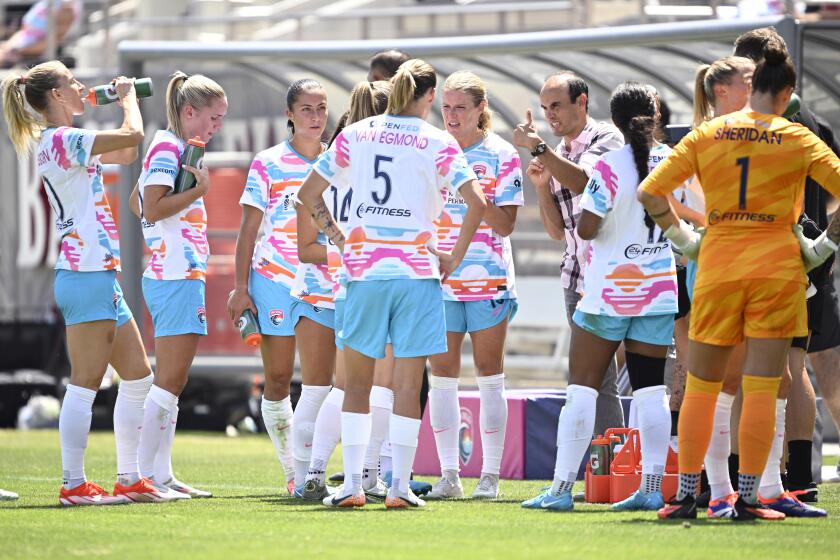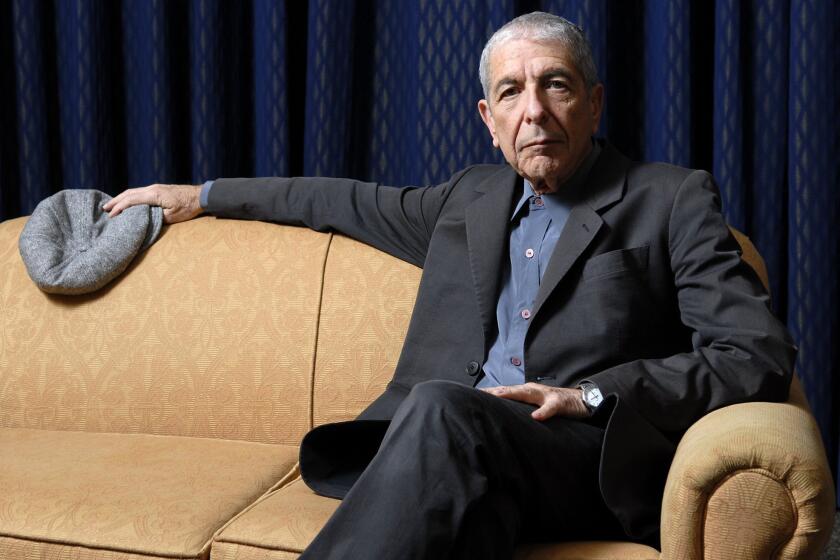Kevin Baxter writes about soccer and hockey for the Los Angeles Times. He has covered seven World Cups, five Olympic Games, six World Series and a Super Bowl and has contributed to three Pulitzer Prize-winning series at The Times and Miami Herald. An essay he wrote in fifth grade was voted best in the class. He has a cool dog.
- Share via
1
SAN DIEGO — No expansion team in MLS history had a more successful launch than LAFC, which played in two MLS Cup finals, two CONCACAF Champions League finals and won two Supporters’ Shields and a U.S. Open Cup in its first six-plus seasons. And some of the credit for that goes to Tom Penn who, as a founding owner and the team’s first president, laid the foundation for that success.
So when Penn migrated south three years ago and began laying the foundation for another expansion club, this time in San Diego, it was assumed he’d simply dust off the same blueprints.
In reality, however, the two experiences couldn’t be more dissimilar.
When LAFC launched it had no stadium, no academy and no training complex. By the time San Diego FC plays its first MLS game next winter, it will have all of those things. When LAFC launched, it was entering a crowded sports market that had 10 professional teams and two major college programs. San Diego FC will have only baseball’s San Diego Padres, the NWSL’s San Diego Wave and San Diego State as competition for attention and ticket sales.
The Los Angeles Kickers won multiple U.S. Open Cup titles in the 1950s and ‘60s. Players on those teams will be honored before Wednesday’s final.
“It’s different,” Penn confesses.
But what really makes the two projects distinct is the management group Penn has put together at SDFC.
Egyptian businessman and politician Mohamed Mansour brings not just deep pockets, but also ownership of the “Right to Dream Academy”, a wildly successful residential school and soccer training program with facilities in Egypt, Ghana and Denmark.
In partnership with the Sycuan Band of the Kumeyaay Nation, the team’s other major investor, Mansour is expanding the program’s reach by building a 28-acre state-of-the-art academy on rugged tribal land about 25 miles east of San Diego, a facility SDFC will use for its first-team training center. The training center, which also boasts a massive gym and five full-size soccer fields, is expected to be ready for the club’s first practice session in January.
“This is completely different,” said Penn, sitting in a third-floor conference room of his team’s downtown headquarters, which has a stunning rooftop view of San Diego Bay. To inspire a collaborative working environment no one at SDFC, including Penn, has a private office. Instead, the team’s 70 employees share a dozen conference rooms named for iconic soccer players such as Johan Cruyff, Eusébio, Mia Hamm and Andrés Iniesta. And it’s more common to see someone walk between desks dribbling a soccer ball than carrying a cup of coffee.
“This expansion club is owned and operated by experts in youth development who also have a very clear, defined style of play and proven success,” Penn continued. “They are among the best in the world at developing talent. So everything we’re doing in football operations needs to plug into that expertise and that’s totally different than what happened at LAFC, where we created all that from scratch.”

Tijuana was one of the cities San Diego FC held tryouts for aspiring young players looking to join its “Right to Dream Academy.”
(San Diego FC)
A lawyer, Penn was an NBA executive with the Portland Trail Blazers and Memphis Grizzlies, an ESPN commentator and co-founder of the Sports Leadership Institute before becoming a founding owner and later president of LAFC. He acknowledged he knew little about soccer when he took the job, but he has proven to be a quick learner.
“I might have my undergraduate degree now,” he joked. “I’m way further along than I was when we started LAFC.”
As a result SDFC is way further along as well. When LAFC was five months from its first game it had a head coach but it didn’t have a stadium. And it had just one first-team player, Carlos Vela.
San Diego also has a coach in Mikey Varas, hired two weeks ago after a two-game stint as interim coach of the U.S. national team. It also has a deal to play its games at Snapdragon Stadium and has a half-dozen players under contract, including Mexican World Cup performer Hirving Lozano, Danish international Marcus Ingvartsen, English youth international Alex Mighten and former Manchester United defender Paddy McNair.
Commercially SDFC is already a hit, having collected 45,000 season-ticket deposits for its 32,000-seat stadium. The inventory of premium seats, loge boxes and suites is nearly sold out.
Perhaps the most important difference, though, is the training center and the adjoining Right to Dream Academy and residential school, which will have classrooms, dining facilities and living quarters for up to 100 youth players between the ages of 13 and 18. The academy will be run by Joaquin Escoto, the former head of Global Football in the Americas for IMG and a co-founder of Alianza de Futbol, the largest Hispanic youth soccer program in the U.S.

(San Diego FC)
“The teachers are there, the kids sleep there, the gym is there, the fields are there,” Escoto said of the abandoned golf-course hotel the school will replace. “This is a little bit different from other MLS academies.”
That’s far from the only difference though. The academy will be part of Right to Dream’s worldwide network of clubs and academies, which since 1999 has sent 157 graduates on to professional soccer, among them Ingvartsen and Jeppe Tverskov, who will also be moving from Denmark to San Diego next year.
Penn hopes SDFC’s academy adds to that number, even if those players’ time with his club is short.
“That’s not our fear. That’s our goal,” he said. “Nothing would make us happier than to have an 18-year-old Ghanaian or Dane or Egyptian or Mexican make their debut with us and go right to Man U or Man City or somewhere else and star on the world stage.
“That’s what we’re all about. Pathways for development.”
Another important difference is the location. Because the academy and training center is less than 50 miles from the international border, FIFA rules allow SDFC to go 50 kilometers into Mexico to promote the club and recruit players, making it the first MLS franchise with a truly bi-national footprint.
Landon Donovan, the best player in USMNT history, is embracing a somewhat unorthodox approach in his new role as San Diego Wave interim coach.
That also mirrors the city, which sees 60,000 people cross from Tijuana to work in San Diego each day, according to Atenea de la Cruz Brito, an academic at Universidad de Tijuana CUT who studies housing markets along the border.
“I was stunned at how open the border is and how bi-national this place is,” Penn said. “This is a super-sophisticated place.”
And as someone who has become newly sophisticated about soccer, Penn believes San Diego is ready to embrace a club that is not only on the cutting edge of player development, but one that will spare no expense to compete on the MLS level, just as his last club did.
“It’s going to be really challenging,” he said. “But our ownership group is in it to win it.”
⚽ You have read the latest installment of On Soccer with Kevin Baxter. The weekly column takes you behind the scenes and shines a spotlight on unique stories. Listen to Baxter on this week’s episode of the “Corner of the Galaxy” podcast.









